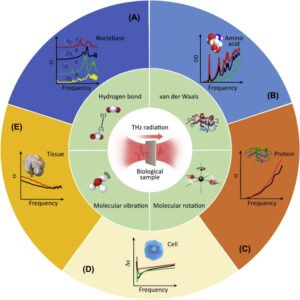Terahertz Emission Spectroscopy
In the realm of scientific exploration, constant advancements in technology pave the way for new discoveries and insights. One such groundbreaking tool is terahertz (THz) emission spectroscopy. This cutting-edge technique harnesses the power of terahertz radiation to probe the properties of materials and molecules, opening doors to a myriad of applications in various fields. In this article, we will delve into the world of terahertz emission spectroscopy, exploring its principles, capabilities, and the remarkable impact it has on scientific research and beyond.

Unraveling the Basics: Understanding Terahertz Radiation
To comprehend the power of terahertz emission spectroscopy, we must first grasp the nature of terahertz radiation. Terahertz waves occupy a frequency range between microwaves and infrared light, typically spanning from 0.1 to 10 THz. This region of the electromagnetic spectrum is often referred to as the terahertz gap due to the historical technological challenges associated with generating, manipulating, and detecting terahertz waves. However, recent advancements have propelled the field forward, enabling the realization of terahertz emission spectroscopy as a transformative scientific tool.
The Principles of Terahertz Emission Spectroscopy
Terahertz emission spectroscopy revolves around the generation and detection of terahertz waves to investigate the properties of materials and molecules. The technique involves exciting a material using a pump source, which could be a laser or an electrical pulse, to induce the emission of terahertz radiation. This emitted radiation carries valuable information about the sample’s physical and chemical properties, including its electronic, vibrational, and rotational characteristics. The emitted terahertz waves are then collected and analyzed using specialized detectors and spectroscopic techniques, providing researchers with a wealth of data to unravel the mysteries of the material under investigation.
Applications in Materials Science and Solid-State Physics
Terahertz emission spectroscopy has made significant strides in materials science and solid-state physics, offering unprecedented insights into the behavior of a wide range of materials. Researchers utilize this technique to study the electronic properties of semiconductors, superconductors, and other crystalline structures. By probing the dynamics of charge carriers, phonons, and excitations, terahertz emission spectroscopy unveils valuable information about the fundamental processes governing the material’s functionality. This knowledge drives advancements in electronics, photonics, and the development of novel materials with tailored properties.
Unveiling Chemical Fingerprints: Applications in Chemistry and Molecular Biology
The unique capabilities of terahertz emission spectroscopy extend to the realm of chemistry and molecular biology, where it serves as a powerful tool for analyzing molecular structures and interactions. Terahertz waves can penetrate many materials, including biological samples, without causing harm, making this technique particularly useful for studying biomolecules such as proteins and nucleic acids. Terahertz emission spectroscopy provides a window into the vibrational and rotational dynamics of molecules, enabling researchers to decipher their chemical fingerprints and gain deeper insights into their structure, conformational changes, and intermolecular interactions. These findings hold great potential for advancements in drug discovery, bioengineering, and understanding the fundamental mechanisms of life.
The Frontiers of Terahertz Imaging and Non-Destructive Testing
In addition to its spectroscopic capabilities, terahertz emission spectroscopy plays a crucial role in terahertz imaging and non-destructive testing. Terahertz waves possess remarkable properties for imaging applications, as they can penetrate many materials, including textiles, paper, plastics, and thin layers. This enables the visualization of hidden structures, the detection of concealed objects, and the identification of material defects or anomalies. Terahertz imaging finds application in fields such as security screening, cultural heritage preservation, and quality control in manufacturing processes.
The Path Ahead: Advancements and Future Directions
As terahertz emission spectroscopy continues to evolve, researchers strive to push the boundaries of its capabilities. Ongoing advancements focus on improving the efficiency of terahertz sources, enhancing detection sensitivity, and developing novel spectroscopic techniques to extract more detailed information from terahertz signals. Furthermore, the integration of terahertz technology with other imaging modalities, such as X-rays and infrared imaging, holds immense promise for multi-modal imaging and complementary data acquisition.
The utilization of terahertz emission spectroscopy stands poised to revolutionize various scientific disciplines and technological fields. From materials science and chemistry to biology and non-destructive testing, this powerful technique empowers researchers to explore uncharted territories, unravel complex phenomena, and pave the way for new discoveries.
So, as we gaze upon the horizon of scientific exploration, let us embrace the extraordinary power of terahertz emission spectroscopy, for it is a beacon of light, illuminating the path toward a deeper understanding of the world around us.
Overcoming Challenges: Terahertz Emission Spectroscopy in Real-World Applications
While terahertz emission spectroscopy holds tremendous potential, it also faces challenges in its practical implementation. One of the primary obstacles is the limited availability of compact and efficient terahertz sources. Generating terahertz waves with sufficient power and bandwidth remains a topic of ongoing research and development. Additionally, terahertz signals are easily attenuated by water vapor and other atmospheric gases, limiting the range and effectiveness of terahertz measurements in certain environments. Despite these challenges, researchers and engineers are actively working to overcome these limitations and make terahertz emission spectroscopy more accessible and robust for a wide range of applications.
Exploring Interdisciplinary Collaboration: The Synergy of Terahertz Emission Spectroscopy
One of the remarkable aspects of terahertz emission spectroscopy is its potential for interdisciplinary collaboration. By bringing together experts from diverse fields such as physics, chemistry, materials science, biology, and engineering, the synergy of knowledge and expertise can lead to groundbreaking advancements. The unique capabilities of terahertz emission spectroscopy can be leveraged to address complex scientific questions and tackle real-world challenges. Collaborative efforts can unlock the full potential of this technique and drive innovation across multiple domains.
Ethical Considerations and Societal Implications
As with any powerful technology, terahertz emission spectroscopy raises ethical considerations and societal implications. The ability to analyze molecular structures, penetrate materials, and detect hidden objects carries both benefits and potential risks. It is crucial to strike a balance between scientific progress and responsible use. Researchers and stakeholders must address concerns related to privacy, security, and the responsible dissemination of terahertz technology. Clear guidelines and regulations should be established to ensure that the utilization of terahertz emission spectroscopy aligns with ethical standards and societal values.
Conclusion: Unleashing the Potential of Terahertz Emission Spectroscopy
Terahertz emission spectroscopy holds immense promise as a transformative scientific tool. By harnessing the power of terahertz radiation, researchers can probe the properties of materials and molecules, unlocking new insights and pushing the boundaries of knowledge. From materials science and chemistry to biology and non-destructive testing, the applications of terahertz emission spectroscopy are vast and wide-ranging.
As advancements continue and challenges are overcome, terahertz emission spectroscopy will play an increasingly significant role in scientific research, technological innovation, and societal advancements. It is a beacon of exploration, shedding light on the mysteries of the universe and empowering us to make groundbreaking discoveries.
So let us embrace the power of terahertz emission spectroscopy, for it has the potential to reshape our understanding of the world and unlock a future filled with endless possibilities.

